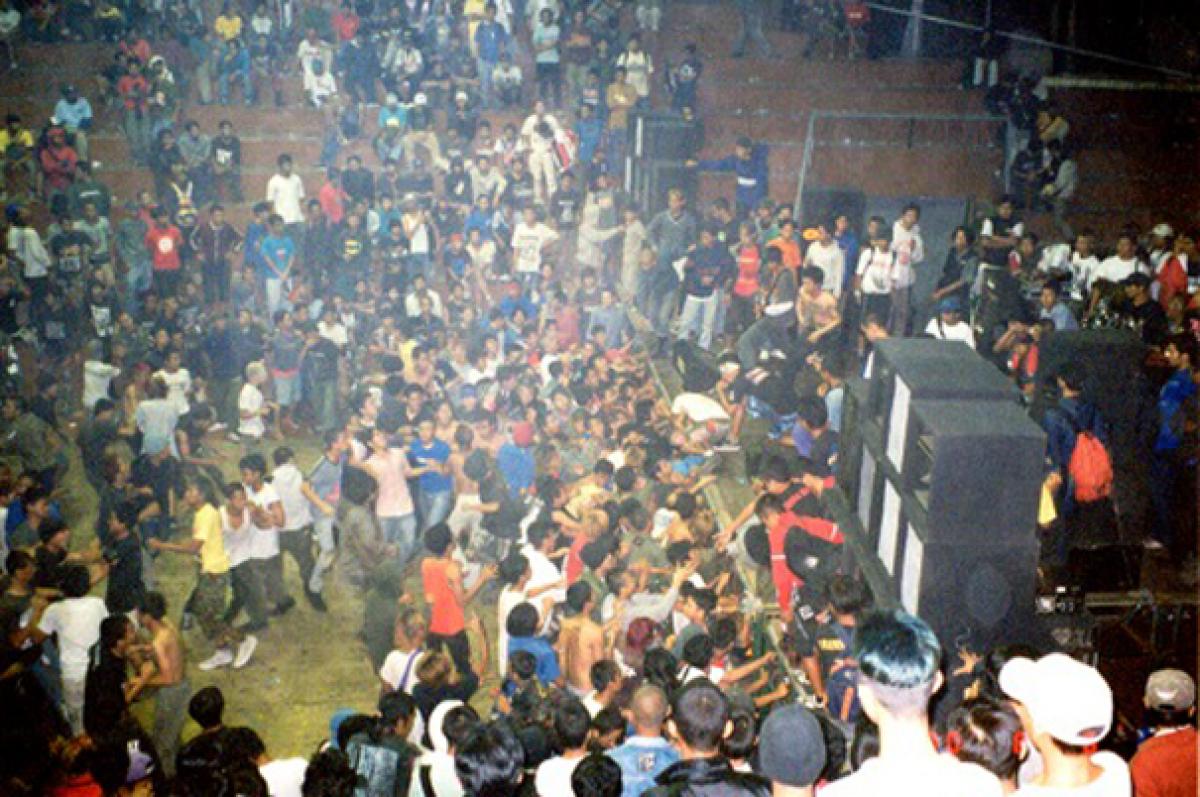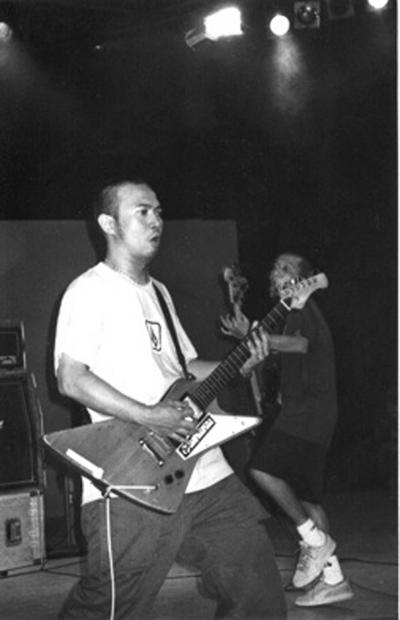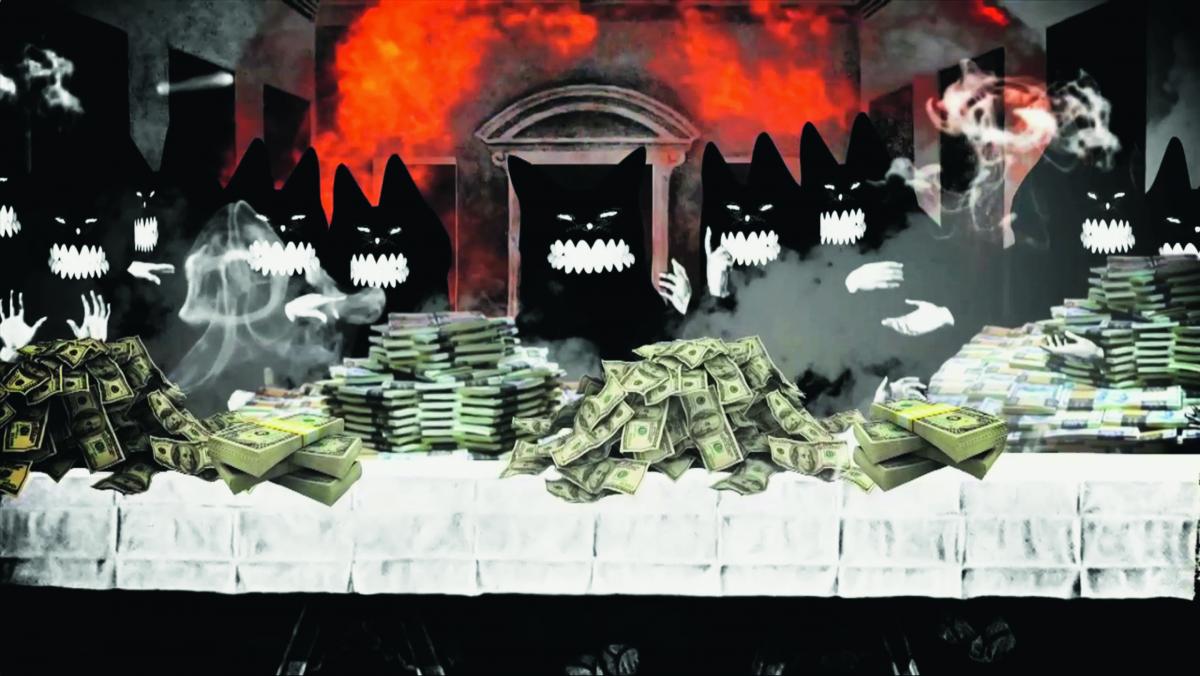
Rock Music in Indonesia
Performing, listening, and recording underground rock shapes an oppositional consciousness among Indonesian youth. This spirit found expression in the grassroots protest movement responsible for toppling the autocratic Soeharto regime in 1998 and fostering the new democratic society in its place. From the Norient book Out of the Absurdity of Life (see and order here).
Irama hidupku membeludak begini, Bunda, tak tertampung dalam tembang nenek-moyang.
The rhythm of my life is bursting forth crazily, Mother; it can’t be accommodated in the song-form of my ancestors.
Minke, the young protagonist in the novel Bumi Manusia (This Earth of Mankind), by Indonesian author Pramoedya Ananta Toer
Tak Ada Asap Tak Ada Api, Tak Ada Perlawanan Tanpa Penindasan.
There is No Smoke When There Is No Fire, There is No Resistance Without Oppression.
1990s Indonesian student movement slogan.
When I first arrived in Jakarta in the fall of 1997 to conduct field research on youth and popular music, I expected to find that at least a few of the most globally-hyped Anglo-American rock bands – Green Day, Nirvana, Metallica – had attracted followings among Indonesian youth as a result of young people’s exposure to these acts through the mainstream commercial mass media – primarily MTV. I did, in fact, find that these groups enjoyed large fan bases among Indonesian young people, but I was unprepared for what else I found.
I had assumed that the rock music diets of Indonesians would be limited to groups promoted by the global music industry. Instead, I discovered an extensive countrywide network of urban scenes dedicated to a genre of music known there as underground. These local scenes not only provided outlets for the sale of esoteric independent rock music from around the world, but also produced their own music cassettes and fanzines, procured rehearsal and recording studio space, and organized massive, all-day concert events that featured dozens of local bands pounding out tunes by their favorite Western groups or, increasingly, their own compositions sung in either English or Indonesian. These events – held on university campuses, in nightclubs, even on soccer fields under the scorching sun – attracted thousands of fans, and were somehow tolerated by the repressive authoritarian regime then ruling the country.
Clearly what I had found in Indonesia could not be explained simply as a consequence of the marketing strategies of multinational media conglomerates, so what was really going on? Anthropological researchers prefer to seek out insiders’ points of view, so I set about trying to find out why young Indonesians were attracted to underground rock music styles, and, in their own words, what motivated them to set up elaborate grassroots networks around the country to support its recording, distribution, and performance. This quest for answers took on added urgency after the dramatic collapse of the Soeharto dictatorship in 1998, as I began to explore the links between the underground music movement and the Indonesian movement for democracy, in which young people played a crucial role.
From the outside, the popularity of underground rock music in 1997 Indonesia appeared to exemplify the dark side of encroaching globalization in the developing world. The visitor to an underground music festival in Jakarta, Bandung, Yogyakarta, Surabaya, Denpasar, or any other large Indonesian city was confronted by crowds of black T-shirt clad young men (and a much smaller number of young women in similar attire) who appeared to be jettisoning their indigenous cultures in a headlong rush to embrace the music and fashion of the hypercapitalist West, joining the ranks of the world’s atomized, apolitical consumers. But the reality was more complicated: by the time I returned to Indonesia in the fall of 1999 to commence a year of dissertation fieldwork, Indonesian underground music, once dismissed by many grownups as a fad or as evidence of outright brainwashing by Western corporations, had become the soundtrack for an activist youth movement that helped topple an entrenched thirty-two-year military dictatorship and start Indonesia on an ultimately successful road to democracy.

An Unsung Muslim Democracy: Indonesia’s Political Transition
Although it is known to many Westerners primarily as a place of tsunamis, earthquakes, and terrorist attacks, Indonesia is also the world’s largest Muslim-majority nation and the fourth most populous country in the world after China, India, and the United States. Since the fall of Soeharto’s «New Order» regime in May 1998, Indonesia has also become the third largest functioning democracy in the world, and in 2004 the first popularly elected president in the nation’s history took office after a general election widely praised for its procedural fairness as well as its extraordinarily high voter turnout (much higher than that of the 2004 U.S. Presidential election). During his March 2005 testimony before the U.S. House of Representatives Subcommittee on Asia and the Pacific, Dr. Douglas Ramage, the Asia Society Representative in Indonesia, asserted:
Indonesia in 2005 should not be seen as a nation in crisis. Following a lot of turmoil over the past several years, Indonesia has emerged as a relatively stable country, with a highly decentralized, democratic system of government. Indonesia, under its recently elected President Susilo Bambang Yudhoyono, is continuing on a path of democratic consolidation and slowly improving its economic performance. Despite the earthquake and tsunami devastation in Aceh, Indonesia should be considered to be in relatively good shape – particularly given the fairly dire predictions and worries of the past several years.
The spectacular success of the new democratic Indonesia, which in 2013 is a prospering, stable nation that has managed to avoid both ethnic Balkanization – in spite of the country’s staggering linguistic and cultural diversity – and large-scale seduction of the mostly Muslim populace by radical Islamic ideology, does not mark the first time that this island nation has proven the skeptics wrong: the demise of President Soeharto’s autocratic New Order government in the wake of the 1997–98 Asian economic crisis shattered widely held assumptions about the impotence of Indonesia’s civil society and the strength of its totalitarian state. At the time, observers both inside and outside the country marveled at the seemingly instantaneous evaporation of a «top-down» culture of timidity, fear and docility, and its replacement by a cacophony of unruly voices competing in a thriving democratic public sphere. The pivotal role of university student protesters in the regime’s downfall and in Indonesia’s subsequent democratic transition also caught many observers by surprise, particularly those who had previously bemoaned the young generation’s perceived apathy and lack of interest in politics.

In reality, the involvement of Indonesian youth in the political upheaval that resulted in President Soeharto’s downfall and Indonesia’s transition to democracy was hardly unprecedented. Until the late 1970s, Indonesian young people had historically played a major role in national politics: passionate student activists had pushed Indonesian nationalist leaders to declare independence from the Netherlands in 1945, just as they hastened the removal from power of Indonesia’s first president, Sukarno, in the wake of a failed (or perhaps staged) coup attempt in 1965. It was in the bloody aftermath of that coup attempt – including the massacre of hundreds of thousands of Indonesians believed to be sympathetic to the coup plotters – that then-General Soeharto seized power and installed his pro-Western New Order government. During its subsequent thirty-two-year reign, the Soeharto regime became notorious for its ruthless pro-development policies, the pervasiveness and venality of its corruption, and its brutal, paranoid suppression of dissenting voices, which included the arrest and imprisonment of some of the country’s most important novelists, musicians, and cultural critics. The New Order government also banned hundreds of important scholarly and literary works, including the four novels of Pramoedya Ananta Toer’s celebrated Buru Quartet.
Despite the New Order’s attempts to instill a culture of repression and conformity, major student demonstrations against the Soeharto government erupted in both 1974 and 1978. After the 1978 protests, however, the New Order regime began a concerted effort to eliminate dissent in the younger generation, particularly in universities. Anthropologist James Siegel has observed that in the 1980s Indonesian mass media outlets replaced the politicized term pemuda (youth) with the apolitical and «teenybopperish» word remaja (teenager) in their representations of middle class Indonesian youth culture. This new label implied a materialistic concern with fashion and lifestyle, and a preoccupation with consuming the diluted Western styles offered by the national popular culture industry. In the course of my research I found that for many young people, underground rock music – both imported and locally produced – was among the most important cultural forces that disrupted this comfortable, somnambulant youth-consumer identity.
Indeed, observers and pundits who dismissed 1990s Indonesian youth as materialistic, self-interested, apolitical conformists had apparently overlooked developments in the youth-oriented popular music of the time. Long before the Internet dramatically expanded young Indonesians’ access to popular music from around the globe in the late 1990s, Indonesian underground music fans had successfully tapped into a proto-cyberspace international network of photocopied fanzines and independent mail order music catalogs responsible for sustaining independent, anti-commercial music scenes in the U.S. and around the world since the early 1980s. Working from these source materials, Indonesian youth – mostly middle-class high school boys, in the beginning – began to develop their own variations of the sounds, images, and rhetoric they contained, using them for their own expressive ends.
Punk, Hardcore, Metal and Alternative

In response to its myriad global influences, the Indonesian underground music movement in the 1990s could be divided into four basic genres: punk, hardcore, metal, and alternative. Each of these genres contained a plethora of substyles, with new varieties continually emerging. Punk was the most conservative category – Indonesian punk bands generally insisted on singing in English and closely modeled their music on the sounds of classic 1970s punk bands and/or the newer pop punk groups. Indonesian metal, in contrast, was constantly evolving in response to the rapid development and stylistic fragmentation of underground subgenres such as death metal, black metal, and grindcore in the international extreme metal community. Hardcore, which originally evolved out of punk in the US in the 1980s, was considered a separate genre in Indonesia and was further broken down into «old school» and «new school»; the former resembled louder, faster punk music, while the latter added hip hop and metal influences to the mix. Hardcore in Indonesia, as elsewhere, is known for its explicitly political lyrics, and was one of the first underground genres to experiment with writing songs in blunt, everyday Indonesian rather than in English. Alternative or «indie» rock was the final catch-all category, which included bands influenced by a range of Western rock artists, from Nirvana to The Cure.
Each of these genres and subgenres attracted socially differentiated audiences. Death metal was popular in the capital, while black metal, with its occult themes and dramatic stage shows, was popular in the more «traditional» provinces, where it was said to resonate with local folkloric beliefs about evil spirits and supernatural powers. While hardcore music largely remained the domain of middle-class youth, both punk and metal music had significantly expanded beyond the middle-class student audience and attracted legions of young proletarian fans around the country.

Interestingly, aside from a short-lived moral panic fomented by the mainstream national media around «satanic» black metal music in the mid 1990s, there had been remarkably little adult condemnation of the underground music movement in Indonesia. In fact, many Indonesian newspaper and magazine features instead portrayed the most successful underground musicians in a positive light, emphasizing their idealism, autonomy, and uncompromising commitment to their creative endeavors. The underground also proved to be fertile ground for generating the latest trends in commercial pop music: albums by so-called «pop alternatif» bands such as Sheila on 7, Padi, and Cokelat, many of whom got their start in local underground rock scenes, provided the mainstream Indonesian music industry with some of its top sellers in 1999–2000. While the relatively melodic and accessible «alternative» underground bands tended to hold the most crossover potential, a number of established punk, hardcore, and metal groups would also chose to sign with large national or multinational (major) record labels, including veteran Jakarta metal stalwarts Suckerhead and the Balinese punk band Superman Is Dead.
While many mainstream musicians and music producers remained wary of releasing music that was too politically tajam, «sharp,» even in the post-Soeharto period, underground artists have been especially bold in their critiques of Indonesian politics. Indeed, this had been the case even before Soeharto’s resignation. For example, two years before the fall of the Soeharto regime, Surabaya-based death metal band Slowdeath released the song «The Pain Remains the Same», a song recorded in English with the following lyrics:
Arise against this unjust system that always fooled us
Chronic corruption never put to an end
Political distortion manipulates the system
Social sterilization sacrificing the people.
Crusade against these feudalistic norms that enslave us
Collusion between entrepreneurs and officials
Colonialistic patterns brought again to life
Exploiting the people for their own profit
Only a few million poor left?
That’s a big fucking lie
Never trust their propaganda
Bored with their lies
Stop this wrong system, something must be done
Why must we go on, to satisfy their gains?
There’s no difference between D**** C********** and the N** O****
So, all that we can say is:
The pain remains the same!
From the album From Mindless Enthusiasm to Sordid Self-Destruction. Recorded September 1, 1996.
While the four key words in the third-to-last line of the song were «censored» in the lyric sheet that accompanied Slowdeath’s cassette, anyone familiar with Indonesian history and the English language would know that it really says: «There's no difference between Dutch Colonialism and the New Order» – a dangerously bold statement at a time when President Soeharto still held a firm grip on power.
Toward a Democratic Culture
One of the Indonesian underground’s most articulate spokespeople is Yukie, the lead singer of Pas, a seminal alternative band who played a key role in creating Bandung’s thriving underground scene. During an interview in late 1999, Yukie explained to me that while «moralists» in his country might decry the existence of «degenerate», mohawk-sporting underground youth, he would counter that the emergence of the underground rock movement in Indonesia is evidence that Indonesian young people are making their own choices. During the New Order, he explained, the Indonesian people were made ignorant and forced to hold the same opinions. Individuals were discouraged from standing out. Nowadays, while the «fundamental aspects» of Indonesian culture remain constant («We’re still Indonesians, we eat rice, not potatoes!»), Indonesian youth are increasingly compelled to think for themselves and to develop the courage to disagree with others – even their friends – on important political issues. Thus underground music, by this reasoning, is an important component in an emerging culture of democracy in Indonesia, as it encourages the development of preferences that differ from established norms of society (i.e., mainstream popular music).
Democracy and the Underground
With its exhortation to throw off the chains of previous generations’ assumptions and prohibitions, rock music has always been allied or at least associated with progressive social change and with the most future-oriented social category in modern and modernizing societies: youth. In late 1990s Indonesia, underground rock’s musical critique took many forms, from supernatural representations of evil to Marxist diatribes against global capitalism. Indonesia’s most successful underground bands from that time, such as Betrayer, Cryptical Death, Purgatory, Step Forward, Suckerhead, Tengkorak and Trauma from Jakarta, Cherry Bombshell, Balcony, Burger Kill, Koil, and Puppen from Bandung, Slowdeath from Surabaya, Eternal Madness and Superman Is Dead from Denpasar, and Death Vomit from Yogyakarta, whether or not they chose to make the move to larger commercial music labels, forged distinctive individual styles and produced songs that directly and eloquently addressed the fears, emotions, and aspirations of Indonesian youth at a momentous time. As the topic of democratization in the Muslim world continues to spur passionate debate, these bands and the thousands more like them in the Middle East, North Africa, South Asia, and elsewhere deserve our serious attention.
List of References
This text has been published first in the Norient book «Out of the Absurdity of Life».
Readers interested in more information about 1990s Indonesian underground music can consult the English-language sources. Unfortunately, since much underground music in Indonesia from this era was recorded with analog equipment and distributed on analog cassettes, it is often not readily accessible in digitized form on the Internet. Happily, Indonesian underground bands from successive generations are far easier to encounter in cyberspace; in addition, many of the groups mentioned in this essay have remained active into the 2000s and 2010s.
Biography
Shop

Published on August 07, 2018
Last updated on April 09, 2024
Topics
About Tunisian rappers risking their life to criticize politics and musicians affirming 21st century misery in order to push it into its dissolution.
From Korean visual kei to Brazilian rasterinha, or the dangers of suddenly rising to fame at a young age.
A generative practice that promotes different knowledge. One that listens is never at a distance but always in the middle of the sound heard.

